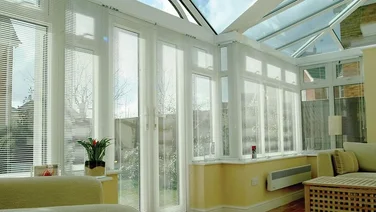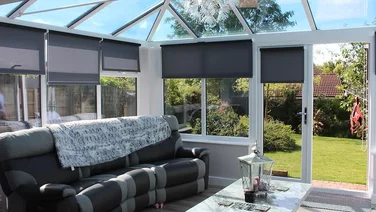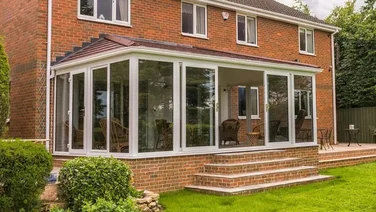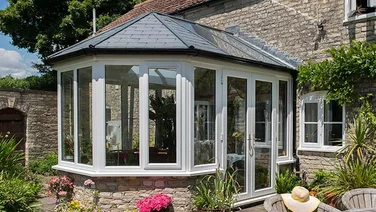- Can I insulate my conservatory roof?
- What are the benefits of insulating my conservatory roof?
- Who much will it cost me to insulate my conservatory roof?
- Types of conservatory roof insulation
- How long does conservatory roof insulation take to install? Can I do it myself?
- Are there any grants for conservatory roof insulation?
- Is your conservatory roof suitable for insulation?
- Is conservatory roof insulation worth it?
- Summary
- Retrofitting a conservatory with a solid roof is the best way to insulate it
- One popular option is to layer insulating material on to the inner roof
- Conservatory roof insulation typically costs between £2,000 and £8,000

While conservatories are traditionally seen as warm-weather-only spaces, with the right insulation they can, in fact, be enjoyed all year round. But, when it comes to conservatory roof insulation, you can’t just go with traditional options such as spray foam.
This is because it can trap moisture, potentially leading to condensation, mold, and rot, especially with the airtight seal it creates, which also prevents proper ventilation.
We’ll review the options for conservatory roof insulation, how much it costs and if it’s worth doing.
Beyond insulating your conservatory, if you want to insulate other parts of your home, such as your walls or loft, we can put you in touch with professional spray foam installers. Simply fill in our short form, and we’ll do the rest.
Get free insulation quotes
Answer a few quick questions, and our trusted installers will send you bespoke insulation quotes – for free.

Example of an internally insulated conservatory roof. Credit: Adobe Stock
Can I insulate my conservatory roof?
Yes, you absolutely can, and you should because it can help you enjoy your conservatory for more days of the year, even when it’s freezing outside. That being said, but how you go about it will depend on the type of conservatory roof you have.
Conservatory roof insulation is usually installed on conservatories with roofs made from glass or polycarbonate panels, because conservatories with solid roofs are already well insulated.
The best way to insulate a conservatory with a glass or polycarbonate roof is to replace those panels with a solid roof. Another option is to layer insulating material on to the existing panels.
If your conservatory already has a solid roof and you want to insulate it further, you could always try installing traditional roof insulation, such as blanket insulation, covered with plaster.
What are the benefits of insulating my conservatory roof?
If you insulate your conservatory roof, you can expect:
- A warmer conservatory in the winter
Insulating a conservatory roof will help the room stay warmer in the winter, although it probably won’t be as warm as the rest of the house because the glass offers less insulation.
Around 80% of the heat in an uninsulated conservatory is lost through the roof. This is especially an issue in the colder months, when many conservatories become unusable because they’re simply too cold.
- A cooler conservatory in the summer
Insulation won’t just help in the winter – in the summer, it can help your conservatory stay cool. For example, conservatories with clear roofs can get very hot in the summer, as the sun beats down into the room.
All types of conservatory roof insulation create an opaque roof, which stops the sun from beating down directly into the conservatory, helping to keep the room cooler.
So, when a conservatory roof is made from glass or polycarbonate, there’s only one barrier between the surface. Skylights pose the same problem.
- Reduced noise levels when it rains
Adding insulation to the conservatory roof will also reduce noise levels when it rains.
By adding insulation, you’re creating an extra barrier between the outside of the conservatory roof and the inside of the conservatory, so the sound of rain hitting the roof should be minimised.
- Reduces condensation
Insulating a conservatory should help minimise condensation. Condensation is caused by a difference in temperature between the inside and outside air. Adding insulation will create a barrier between the inside of your conservatory and the cold outside air, reducing the likelihood of condensation building up.
Who much will it cost me to insulate my conservatory roof?
Type of conservatory roof insulation | Average cost |
|---|---|
Solid roof retrofit | £5,000-£8,000 |
Internal roof insulation | £2,000-£4,500 |
External insulating panels | £2,500-£6,000 |
*Prices are averages based on a 9m2 (3m by 3m) conservatory, courtesy of CheckaTrade.
Conservatory roof insulation typically costs anywhere from £2,000 to £8,000. Costs will vary greatly depending on the type of insulation being installed, the materials used, the size of the conservatory roof and your choice of installer.
For example, when retrofitting a conservatory with a solid roof, the type of finish you choose will affect the price. Felt roofing is typically the cheapest option, while roof shingles are the most expensive.
When installing internal conservatory roof insulation, the choice of finish will also affect the cost. A uPVC finish will be cheaper than a wooden one, for instance.
Types of conservatory roof insulation
There are three main types of conservatory roof insulation:
- A solid roof retrofit
Retrofitting a conservatory with a solid roof (i.e., a more traditional roof) – to replace a glass or polycarbonate roof – is the most effective way to insulate it.
That being said, it’s also the most expensive option and could be out of reach for some people. You need to ensure the conservatory frame is strong enough to hold the weight of a solid roof.
If installing a solid roof isn’t possible, the next best option is to install a layer of internal insulation.
- Internal roof insulation
Internal insulation is usually fixed to the inner side of the roof. The insulating material comprises a light, quilted layer (typically made from aluminium foil and wadding) sandwiched between two wooden or uPVC frames.
- External insulating panels
If neither option is appealing, another remedy is attaching insulating panels to the outside of the roof. This method is the cheapest and most light-touch of the three.
The insulating panels are typically made of layers of aluminium and synthetic foam. Most installers also offer a variety of finishes, from uPVC sheets to lightweight plastic tiles.
Get free insulation quotes
Answer a few quick questions, and our trusted installers will send you bespoke insulation quotes – for free.

Example of an insulated conservatory roof. Credit: Adobe Stock
How long does conservatory roof insulation take to install? Can I do it myself?
Installing roof insulation takes between one to three days. Fitting an inner or outer layer of insulation should only take a day as it’s a relatively simple process.
Replacing a transparent roof with a solid roof typically takes three days. The process can last longer depending on how complex the work is and how much you want done – for example, installing lights in the new conservatory ceiling will add to the installation time.
Generally, it’s best to leave insulating your conservatory roof to the professionals. For example, adding extra weight to the conservatory, such as insulating sheets or a whole new roof, can be risky if the conservatory frame isn’t strong.
We recommend you get your conservatory professionally assessed before starting any work.
One DIY option is to install multifoil insulation. This involves attaching timber battens underneath the roof, stapling 25 mm thick multifoil insulation, and finishing with plasterboard or uPVC cladding, significantly reducing heat loss.
Alternatively, applying 0.1 to 0.2 mm thick thermal window film directly onto clean glass panels offers a quicker, more straightforward method, enhancing energy efficiency and comfort, though it is less robust.
Another option is to source and install DIY insulation kits. In all cases, they are not the most effective form of insulation, and depending on your skill level, they might not be the best-looking once finished.
But if you like the look of your glass conservatory roof, insulating foil can be a good temporary measure for the winter months.
Are there any grants for conservatory roof insulation?
There are no grants specifically for conservatory roof insulation.
It might be possible for you to fund the process of insulating your conservatory roof with one of the government’s many insulation grants, but only if your conservatory isn’t sealed off from the rest of your house – for example, if the living room opens straight into it.
In this scenario, insulating your conservatory would help your home’s energy efficiency overall, potentially making you eligible for a grant.
Grants such as the ECO4 scheme – and the Nest scheme in Wales – offer funding to low-income households or those on certain benefits for energy-efficient home improvements.
Is your conservatory roof suitable for insulation?
For a conservatory roof to be suitable for insulation, the structure must be strong enough to withstand the extra weight. This can be an issue for conservatories where the walls are entirely made of windows, without any solid walls in between them.
A qualified contractor or architect should determine whether your conservatory roof is strong enough to house a new solid roof or a layer of internal insulation. If the conservatory isn’t suitable for a solid roof retrofit or internal insulation, external insulation panels might still be an option.
External panels are the lightest, most low-touch form of professional insulation, and are suitable for most conservatories. If that’s impossible, you can insulate your conservatory in other ways. Adding carpets and insulated curtains can help preserve heat and make it feel cosier.
Insulation in a conservatory roof should be between 20 and 30 millimetres thick. This is less than required for walls and lofts within the rest of your house, where the recommended thickness is between 150 and 200mm. Most conservatory roofs can’t take the weight of thick insulation, so they don’t need to be as thermally sealed as rooms you spend all your time in.
Is conservatory roof insulation worth it?
Yes, it definitely is if you want to take advantage of your conservatory throughout the year.
Having an uninsulated open-plan conservatory will decrease the energy efficiency of the rest of your home, making it feel cold in the winter. Plus insulating your conservatory roof will help keep heat inside the adjacent rooms.
If you don’t plan on using your conservatory outside of the summer months, and treat it more like a part of your garden, insulation might not be worth it.
Summary
- Insulating your conservatory roof can make it usable all year round, reducing heat loss in winter and preventing overheating in summer.
- The best insulation method depends on your roof type, with solid roof retrofits being the most effective but expensive option.
- Internal and external insulation panels offer more affordable alternatives, though their effectiveness varies.
- While conservatory roof insulation can lower energy costs and improve comfort, structural suitability must be assessed before installation.
- There are currently no grants for conservatory roof insulation, but if your conservatory is open to the rest of your home, you may qualify for broader energy efficiency schemes.







